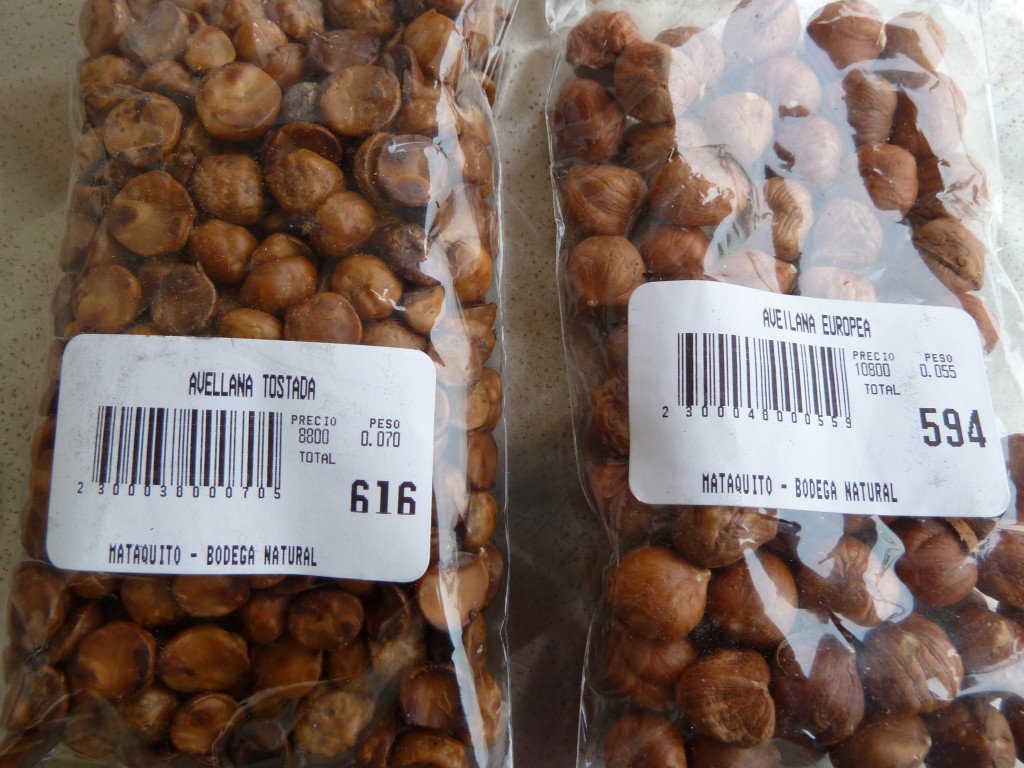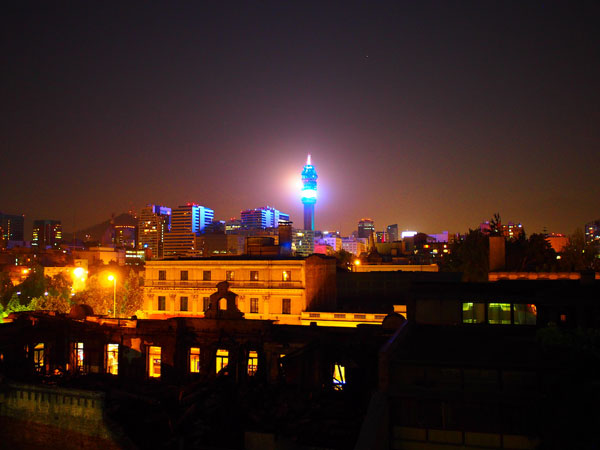Avellanas.
Avellanas are hazelnuts. And you know hazelnuts (or filberts as I used to call them). Tasty and creamy, nutty and a good addition to chocolate to make the delicious and transfat-rich Nutella.
And they look like this: (and by the way, I got them from one of my favorite tostadurías (el Mataquito) for semi-interesting nuts, like pumpkin seeds, and sometimes “european hazelnuts” and always brown sugar. Two locations, one on El Bosque Norte not far off Apoquindo, west side of the street, and one on Avda. Matta, at about altura 800 (this one is bigger).
And then then there’s the Chilean hazelnut. For one thing, it comes from a totally different plant. And therefore, it looks (and tastes) totally different. The Chilean hazelnut comes split, and toasted. It’s not quite as greasy as the European, breaks into pieces in your mouth (more like a soynut than a peanut), and has a greener flavor, almost bordering on toasted and grassy at the same time. The tree it grows on is actually an evergreen, so maybe it tastes a little like that. And it looks like this:
As you can see, they look totally different. Here’s a side-by-side:
The European hazelnut (which is what you think of when you think of hazelnuts, or avellanas, are the species Corylus avellana, whereas the Chilean ones are Gevuina avellana. At first, this led to great disappointment on my part, when people would offer me hazelnuts, and these, small, brittle, halved pretend hazelnuts would appear.
They’ve grown on me, like queso fresco (but never quesillo) that sort of solid ricotta of a cheese that shows up on vegetarian sandwiches sometimes, but unlike manjar or mil hojas “cake” (see, cardboard plus manjar (milk fudge, dulce de leche), sometimes with meringue on top) or even the maligned membrillo, which I cooked with water and sugar as I was instructed, and now I have a solid bowl of cooked membrillo with a spoon sticking out of it, which I will try to eat sometime with yogurt, but my friends, membrillo lovers all, I’m afraid I may not be woman enough to get it down.
So, surprises be darned, now I’ve got two little bags of nuts to munch on as the winter chill seeps into our houses. I wonder what food (or foodstuff) I’ll write about next.
Gratuitous final shot of the nuts in bags, so you can compare price per kilo, if you are so inclined:














Interesting that the European hazelnuts cost less than the “nacional.” I would presume that they’re imported, no?
And, my friend…..membrillo, quesillo, and I do not get along. Not a fan of manjar either. Hope they don’t revoke my visa for admitting that!
If you read the fine print, there are more chilean hazelnuts (by weight) than the euro ones. I think there were 70 grams and 55 grams, respectively. I’m sure they won’t revoke your visa, so long as you eat completos. (oops, I don’t do that, either). The membrillo goo in my fridge is just mocking me now, I know it. I also dislike string beans on my sandwich. I’m a failed emigreé. 🙂
Avellanas, castañas, nuez ,etc…frutos secos,puras delicias
para tentarnos a comer!!! Además, ayudan a la salud. Ud nos va a seguir tentando con esos ricos alimentos??? Ojalá que si…saludos!!!
I had no idea they were different! I’ve never really eaten plain European hazelnuts, so I figured the Chilean ones were just slightly smaller. Thanks to you, I’ve learned something today.
This cracked me up. I so know what you mean about the dulce de leche-dry mouth cake and most definitely with membrillo. Same with dulce de batata. They make my teeth curl, all of them.
I am curious to know, though. How do the Chillean ones taste in chocolate?
I can’t even imagine how they would taste in chocolate. It would be like mixing mate with chocolate milk. They seem like two flavors (and textures) that wouldn’t go well together. Do you know about the Chilean piñones? Those are so not pine nuts as we know them. Wet and rubbery and more like a potato than a nut. Oh! sufrimiento del extranjero! So hard!
I have seen the Chilean hazelnuts but it never clicked that they were supposed to be the same as European hazelnuts. They look very different.
And I think I am Chilean… I love all of the above, (especially green beans on my sandwich!) Here in the North they like to eat dulce de membrillo on bread or crackers with a slice of goat’s cheese, surprisingly nice.
Of course, each country has it’s “special” foods. Can’t take “fish and Chips” away from the Brits, or the yummy stuff that goes with them… vinegar, gravy, curry sauce or mushy peas! (and some people prefer just the fried batter without the fish!) 🙂
I could have a meal with those people who like the fried batter and not the fish, because I’m not crazy about the fried batter after a couple of bites.
I don’t mind dulce de membrillo, but I’m not sure I’ve ever bought it. Though I do have a home-made variety in the fridge now, which I will dutifully eat. I had some with plain yogurt yesterday and it wasn’t bad.
Hoping to get to see you sometime when I’m in the north, btw! Would love to come for an (uninvited) visit! Mostly I want to look at the pretty yarn.
Let me know when you come north and I will invite!
I have never bought dulce de membrillo but my mother-in-law makes it every year from her own trees. She is always experimenting with her recipe, changing slightly the colour and sweetness.
Try the membrillo mixture topped with vanilla sauce, or custard. It cuts the very sweet taste, and is the old fashioned way that Dulce de Membrillo was served in years gone by.
not a big fan of either vanilla sauce or custard, but I have been eating it with greek yogurt, which is closeish, I guess. Thanks for popping by!
I LOVE Chilean Hazelnuts and am desperate to find a source. I live in central CA. I keep searching the web but can’t find them.Any suggestions?
this is a problem I have not come across before! There’s a couple of places that import Chilean food, but most of it packaged. If I find a source, I’ll be sure to let you know. I could send you some, but I think as an agricultural product, they’re likely to get stopped on the way! BTW, they’re growing on me, too!